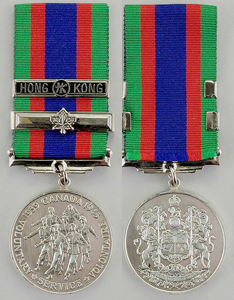Invasion of Hong Kong and Occupation of Indochina
After Japan captured Canton in 1938. Hong Kong became a smuggling route for weapons bound for Chiang Kai-shek's nationalist forces. Anticipating trouble, two thirds of the population of Hong Kong had fled before the Pearl Harbor attack. On December 8, 1941, a dozen Japanese battalions invaded Hong Kong and captured the colony by Christmas Day 1941, after overpowering a British garrison guarded by British, Canadian, and Indian soldiers. Despite pleas from the Hong Kong governor to "Fight on! Hold fast for King and Empire" neither the Chinese nor the British in the colony put up much of a fight. The Japanese, conquerors of Hong Kong, feared a Chinese "Fifth Column." In response, they deported hundreds of thousands of Chinese to the mainland.
After Germany captured Paris in May 1940, the Vichy French government gave the Japanese access to French Indochina (Vietnam, Cambodia, and Laos) for the duration of World War II. The former French holdings proved to be a convenient staging area for raids on China. Later it also provided Japanese soldiers with a staging area for their advance on Malaysia, Singapore, Thailand, and Burma.

Canadian Volunteer Service Medal - Bar Hong Kong
The obverse of the 36mm, silver Canadian Volunteer Service Medal depicts seven marching figures, representing men and women of the army, air force, navy, and nursing service. Around the rim is the inscription 1939 CANADA 1945 VOLUNTARY SERVICE VOLONTAIRE. The seven marching figures were based on real people taken from National Defense photographs. The reverse depicts the coat of arms of Canada. These Medals were issued unnamed.
The Hong Kong Bar, instituted in April 1994, was awarded to those involved in the short-lived Battle of Hong Kong during the period of December 8-25, 1941. Two Canadian battalions totaling 1,982 men were based in Hong Kong and took part in the battle.
After Japan captured Canton in 1938. Hong Kong became a smuggling route for weapons bound for Chiang Kai-shek's nationalist forces. Anticipating trouble, two thirds of the population of Hong Kong had fled before the Pearl Harbor attack. On December 8, 1941, a dozen Japanese battalions invaded Hong Kong and captured the colony by Christmas Day 1941, after overpowering a British garrison guarded by British, Canadian, and Indian soldiers. Despite pleas from the Hong Kong governor to "Fight on! Hold fast for King and Empire" neither the Chinese nor the British in the colony put up much of a fight. The Japanese, conquerors of Hong Kong, feared a Chinese "Fifth Column." In response, they deported hundreds of thousands of Chinese to the mainland.
After Germany captured Paris in May 1940, the Vichy French government gave the Japanese access to French Indochina (Vietnam, Cambodia, and Laos) for the duration of World War II. The former French holdings proved to be a convenient staging area for raids on China. Later it also provided Japanese soldiers with a staging area for their advance on Malaysia, Singapore, Thailand, and Burma.

Canadian Volunteer Service Medal - Bar Hong Kong
The obverse of the 36mm, silver Canadian Volunteer Service Medal depicts seven marching figures, representing men and women of the army, air force, navy, and nursing service. Around the rim is the inscription 1939 CANADA 1945 VOLUNTARY SERVICE VOLONTAIRE. The seven marching figures were based on real people taken from National Defense photographs. The reverse depicts the coat of arms of Canada. These Medals were issued unnamed.
The Hong Kong Bar, instituted in April 1994, was awarded to those involved in the short-lived Battle of Hong Kong during the period of December 8-25, 1941. Two Canadian battalions totaling 1,982 men were based in Hong Kong and took part in the battle.
Website Maintained by Keith Emroll